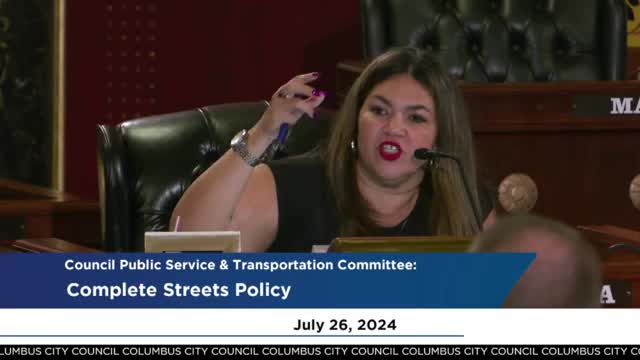City plans bold changes to enhance neighborhood streets
July 27, 2024 | Columbus City Committees (Regular Meetings), Columbus, Franklin County, Ohio

This article was created by AI summarizing key points discussed. AI makes mistakes, so for full details and context, please refer to the video of the full meeting. Please report any errors so we can fix them. Report an error »

During a recent government meeting, city officials discussed ongoing initiatives aimed at enhancing urban infrastructure and community engagement, particularly focusing on the Complete Streets program and the 614 Beautiful initiative.
Council members emphasized the importance of creating inviting public spaces, such as seating areas and gathering spots, particularly at key intersections. They noted that different neighborhoods may require tailored approaches, drawing from successful strategies implemented in various cities. The goal is to ensure that street designs evolve to meet contemporary needs while maintaining community character.
A significant point raised by resident Milt Baufman highlighted concerns regarding the impact of proposed bike lanes on Broad Street, a highly residential area with limited parking. Baufman expressed support for bike lanes but urged for thoughtful design that considers the needs of local residents, especially in neighborhoods with historic characteristics. He called for more robust feedback mechanisms for residents affected by these changes.
City officials responded by outlining their commitment to community engagement. They detailed plans for public meetings and outreach efforts to gather input on roadway projects, particularly along Broad Street. A year-long pilot program is set to test changes in the area, with surveys and focus groups planned to ensure resident voices are heard throughout the process.
The meeting underscored a collaborative approach to urban planning, aiming to balance infrastructure improvements with community needs and historical preservation. As the city moves forward with these initiatives, officials reiterated their dedication to creating safer, more accessible streets while fostering community involvement in the decision-making process.
Council members emphasized the importance of creating inviting public spaces, such as seating areas and gathering spots, particularly at key intersections. They noted that different neighborhoods may require tailored approaches, drawing from successful strategies implemented in various cities. The goal is to ensure that street designs evolve to meet contemporary needs while maintaining community character.
A significant point raised by resident Milt Baufman highlighted concerns regarding the impact of proposed bike lanes on Broad Street, a highly residential area with limited parking. Baufman expressed support for bike lanes but urged for thoughtful design that considers the needs of local residents, especially in neighborhoods with historic characteristics. He called for more robust feedback mechanisms for residents affected by these changes.
City officials responded by outlining their commitment to community engagement. They detailed plans for public meetings and outreach efforts to gather input on roadway projects, particularly along Broad Street. A year-long pilot program is set to test changes in the area, with surveys and focus groups planned to ensure resident voices are heard throughout the process.
The meeting underscored a collaborative approach to urban planning, aiming to balance infrastructure improvements with community needs and historical preservation. As the city moves forward with these initiatives, officials reiterated their dedication to creating safer, more accessible streets while fostering community involvement in the decision-making process.
View full meeting
This article is based on a recent meeting—watch the full video and explore the complete transcript for deeper insights into the discussion.
View full meeting
